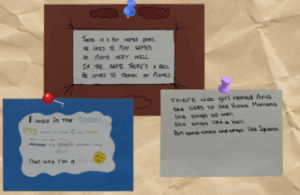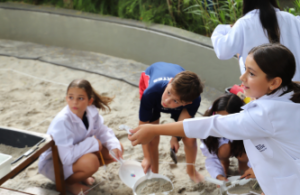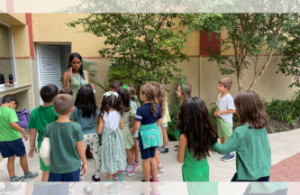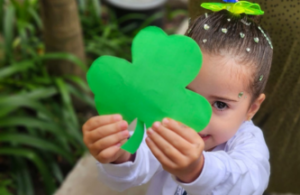Com o espírito curioso e ao mesmo tempo temeroso, o Infantil II e o Preschool 2 receberam em abril uma visita ansiosamente aguardada: a do “homem das abelhas”. Nosso visitante foi o Guilherme Aguirre, biólogo e meliponicultor (criador de abelhas sem ferrão), além de encantador de crianças, por certo.
As crianças pequenas da nossa educação infantil inicialmente repetiram a primeira associação que a figura desses insetos trazia para elas, a de que as abelhas têm ferrão e que elas têm medo delas. Depois da conversa, da apreciação da imensa diversidade desses pequenos seres, da visualização do interior das colmeias e das abelhas em ação dentro delas, da compreensão da importância delas para a manutenção da vida das pessoas, o repertório das crianças se ampliou imensamente.
Assim, saíram espalhando para os outros professores, por exemplo, sobre a abelha verde, abelha solitária das orquídeas, que as surpreendeu e as marcou de maneira especial por sua cor viva e brilhante, e mostrando a força multiplicadora de um contexto de aprendizagem potente. Aprenderam sobre a necessidade de serem “as guardiãs das abelhas” para que nossa escola continue tendo flores lindas, que o pé de amora continue dando frutos e assim a natureza fique saudável.
Que esse efeito multiplicador atravesse os muros da escola e que o conhecimento e a admiração estampados nas crianças se tornem efetivamente gestos concretos de cuidado e valorização tanto das abelhas como das árvores e florestas.
A very special visitor
With curious yet cautious spirits, the children of Infantil II and Preschool 2 welcomed a long-anticipated visitor in April — the “bee man”. Our guest was Guilherme Aguirre, a biologist and meliponiculturist (keeper of stingless bees) — and without a doubt, a true child charmer.
At first, the young children in our early childhood education program echoed the most common association they had with these insects: bees have stingers, and they were afraid of them. But after a rich conversation, observing the immense diversity of these tiny creatures, exploring the inside of hives, and watching bees at work within them, their understanding grew significantly. They came to realize the essential role bees play in sustaining life on Earth.
Eager to share their new knowledge, the children began telling other teachers about, for example, the green bee — a solitary orchid bee that amazed them with its vibrant, shiny color. This moment highlighted the powerful ripple effect of a meaningful learning experience.
They learned about the importance of becoming “bee guardians” to ensure our school continues to have beautiful flowers, fruitful mulberry trees, and a healthy, thriving natural environment.
May this ripple effect reach beyond the school walls, turning the children’s knowledge and awe into concrete acts of care and appreciation — not only for bees but for trees and forests as well.
Professoras do Infantil II e Preschool 2















